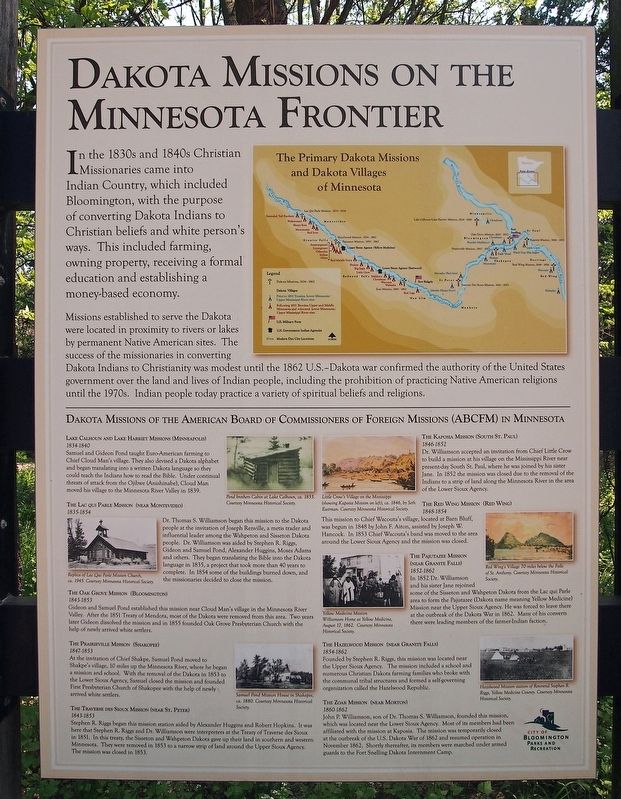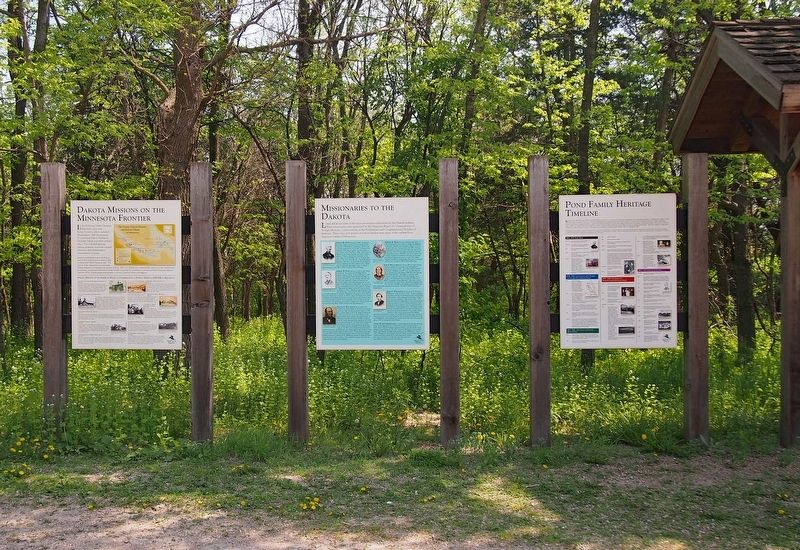East Bloomington in Hennepin County, Minnesota — The American Midwest (Upper Plains)
Dakota Missions on the Frontier
Missions established to serve the Dakota were located in proximity to rivers or lakes by permanent Native American sites. The success of the missionaries in converting Dakota Indians to Christianity was modest until the 1862 U.S.–Dakota war confirmed the authority of the United States government over the land and lives of Indian people, including the prohibition of practicing Native American religions until the 1970s. Indian people today practice a variety of spiritual beliefs and religions.
Dakota Missions of the American Board of Commissioners of Foreign Missions (ABCFM) in Minnesota
Lake Calhoun and Laker Harriet Missions (Minneapolis)
1834-1840
Samuel and Gideon Pond taught Euro-American farming to Chief Cloud Man's village. They also devised a Dakota alphabet and began translating into a written Dakota language so they could teach the Indians how to read the Bible. Under continual threats of attack from the Ojibwe (Anishinabe), Cloud Man moved his village to the Minnesota River Valley in 1839.
The Lac qui Parle Mission (near Montevideo)
1835-1854
Dr. Thomas S. Williamson began this mission to the Dakota people at the invitation of Joseph Renville, a metis trader and influential leader among the Wahpeton and Sisseton Dakota people. Dr. Williamson was aided by Stephen R. Riggs, Gideon and Samuel Pond, Alexander Huggins, Moses Adams and others. They began translating the Bible into the Dakota language in 1835, a project that took more than 40 years to complete. In 1854 some of the buildings burned down, and the missionaries decided to close the mission.
The Oak Grove Mission (Bloomington)
1843-1853
Gideon and Samuel Pond established this mission near Cloud Man's village in the Minnesota River Valley. After the 1851 Treaty of Mendota, most of the Dakota were removed from the area. Two years later Gideon dissolved the mission and in 1855 founded Oak Grove Presbyterian Church with the help of newly arrived white settlers.
The Prairieville Mission (Shakopee)
1847-1853
At the invitation of Chief Shakpe, Samuel Pond moved to Shakpe's village, 10 miles up the Minnesota River, where he began a mission and school. With the removal of the Dakota in 1853 to the Lower Sioux Agency, Samuel closed the mission and founded First Presbyterian Church of Shakopee with the help of newly arrived white settlers.
The Traverse des Sioux Mission (near St. Peter)
1843-1853
Stephen R. Riggs began this mission station aided by Alexander Huggins and Robert Hopkins. It was here that Stephen R. Riggs and Dr. Williamson were interpreters at the Treaty of Traverse des Sioux in 1851. In this treaty, the Sisseton and Wahpeton Dakota gave up their land in southern and western Minnesota. They were removed in 1853 to a narrow strip of land around the Upper Sioux Agency. The mission was closed in 1853.
The Kaposia Mission (South St. Paul)
1846-1852
Dr. Williamson accepted an invitation from Chief Little Crow to build a mission at his village on the Mississippi River near present-day South St. Paul, where he was joined by his sister Jane. In 1852 the mission was closed due to the removal of the Indians to a strip of land along the Minnesota River in the area of the Lower Sioux Agency.
The Red Wing Mission (Red Wing)
1848-1854
This mission to Chief Wacouta's village, located at Barn Bluff, was begun in 1848 by John F. Aiton, assisted by Joseph W. Hancock. In 1853 Chief Wacouta's band was moved to the area around the Lower Sioux Agency and the mission was closed.
The Pajutazee Mission (near Granite Falls)
1852-1862
In 1852 Dr. Williamson and his sister Jane rejoined some of the Sisseton and Wahpeton Dakota from the Lac qui Parle area to form the Pajutazee (Dakota name meaning Yellow Medicine) Mission near the Upper Sioux Aency. He was forced to leave there at the outbreak of the Dakota War in 1862. Many of his converts there were leading members of the farmer-Indian faction.
The Hazelwood Mission (near Granite Falls)
1854-1862
Founded by Stephen R. Riggs, this mission was located near the Upper Sioux Agency. The mission included a school and numerous Christian Dakota farming families who broke with the communal tribal structures and formed a self-governing organization called the Hazelwood Republic.
The Zoar Mission (near Morton)
1860-1862
John P. Williamson, son of Dr. Thomas S. Williamson, founded this mission, which was located near the Lower Sioux Agency. Most of its members had been affiliated with the mission at Kaposia. The mission was temporarily closed at the outbreak of the U.S. Dakota War of 1862 and resumed operation in November 1862. Shortly thereafter, its members were marched under armed guards to the Fort Snelling Dakota Internment Camp.
Erected by City of Bloomington Parks and Recreation.
Topics. This historical marker is listed in these topic lists: Churches & Religion • Native Americans • Wars, US Indian. A significant historical year for this entry is 1835.
Location. 44° 48.828′ N, 93° 16.316′ W. Marker is in Bloomington, Minnesota, in Hennepin County. It is in East Bloomington. Marker is on East 104th Street, on the left when traveling south. In Pond-Dakota Mission Park on east edge of parking area. Touch for map. Marker is at or near this postal address: 401 104th St E, Minneapolis MN 55420, United States of America. Touch for directions.
Other nearby markers. At least 8 other markers are within walking distance of this marker. Missionaries to the Dakota (here, next to this marker); Pond Family Heritage Timeline (here, next to this marker); Changing Landscapes (within shouting distance of this marker); Gideon and Agnes Pond House (within shouting distance of this marker); 1856 Federal Style Gideon H. Pond House (within shouting distance of this marker); Samuel W. and Gideon H. Pond (within shouting distance of this marker); Oak Grove Mission (about 400 feet away, measured in a direct line); Pond Dakota Mission Park (about 600 feet away). Touch for a list and map of all markers in Bloomington.
Credits. This page was last revised on February 12, 2023. It was originally submitted on May 21, 2018, by McGhiever of Minneapolis, Minnesota. This page has been viewed 402 times since then and 38 times this year. Photos: 1, 2. submitted on May 21, 2018, by McGhiever of Minneapolis, Minnesota. • Bill Pfingsten was the editor who published this page.

